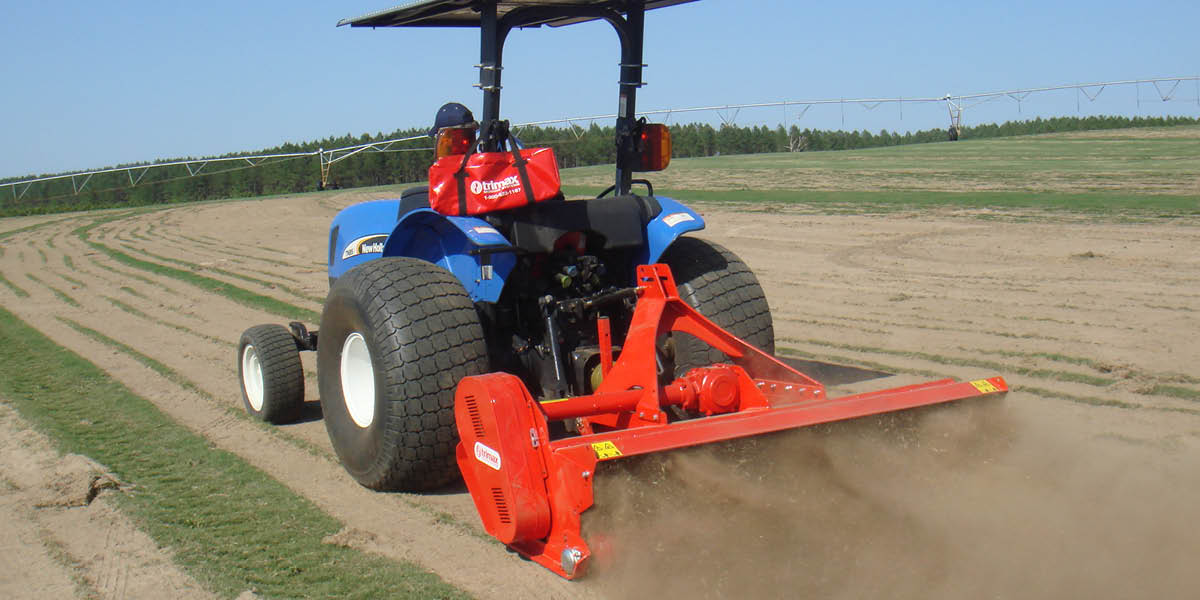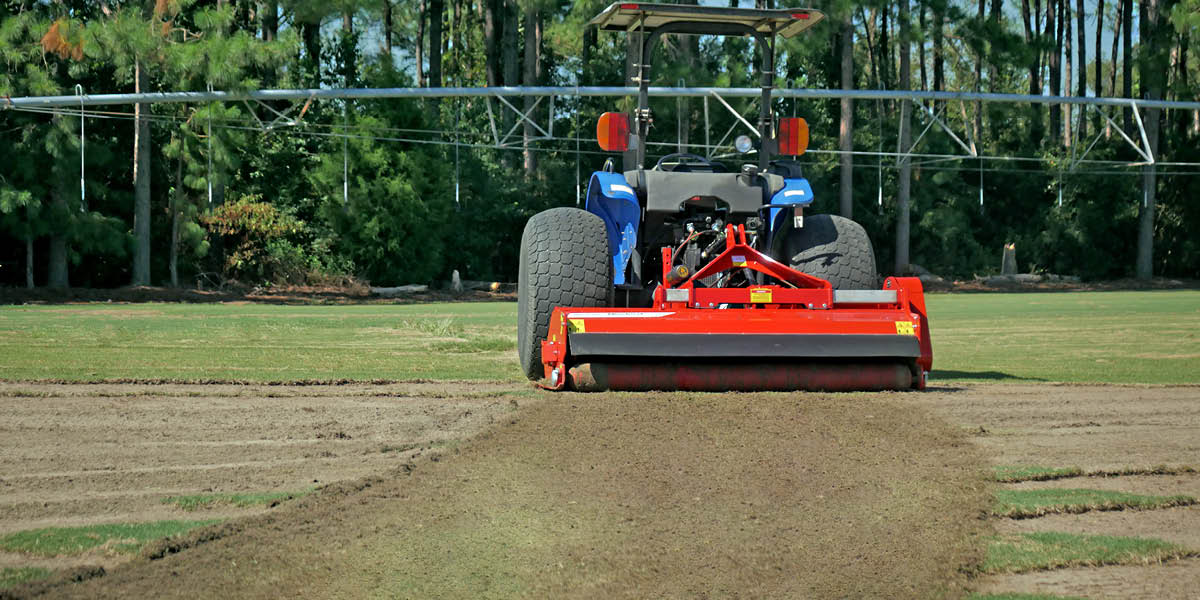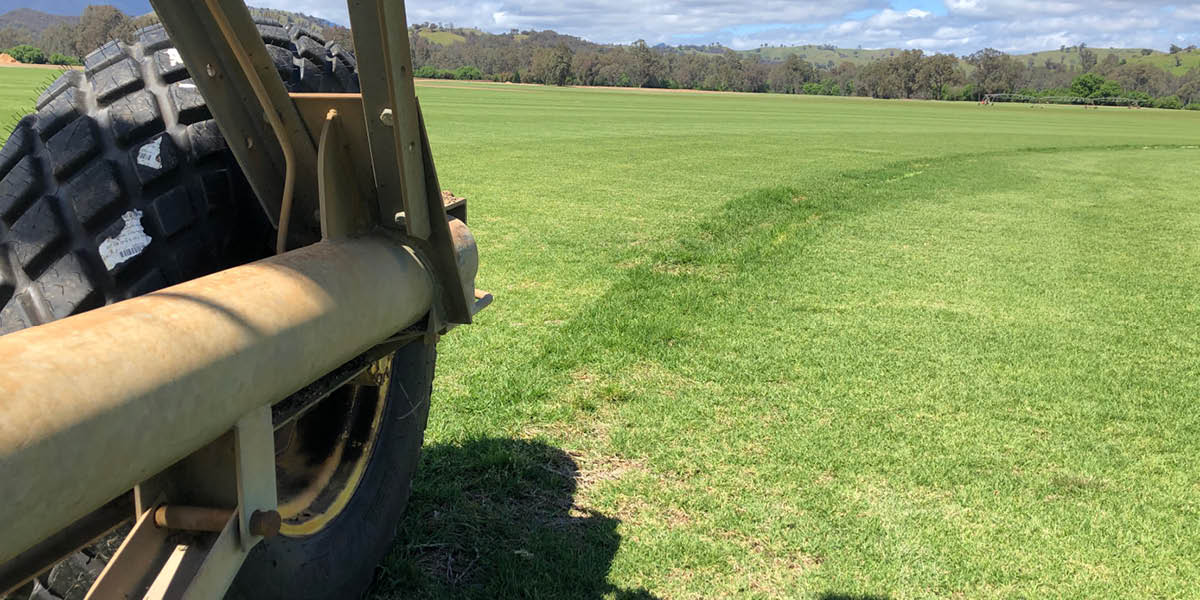While Rotary or Reel Mowers are the gold standard on turf farms for their ability to deliver high-quality cuts and premium presentation on production-grade turf, flail mowers have earned their place in the farm fleet as unexpectedly valuable workhorses that can address a range of common farm maintenance problems.
Trimax Mowing Systems, a global company that designs, manufactures, and distributes commercial Rotary and Flail Mowing equipment, has worked with turf and sod growers around the World to learn how Flail mowers can contribute to your farm’s success. Here are their recommendations.
Opening New Land
The most readily apparent use of a Flail Mower is to open new land for turf growth and development. Flail Mowers are particularly well suited for dealing with heavy growth since they are generally more versatile and robust than Rotary Mowers due to the mass and geometry of the singular central rotor and the individual hammer-type blades. They can also be used to clean up overgrown edges around paddocks that are already operational.
The Trimax Warlord, in particular, is a Flail Mower renowned for its material processing capabilities. It can deliver a tidy cut in spaces with grasses several feet high, and the even dispersal from the rear ensures that the nutrients from the clippings are evenly returned to the soil.
Even if the paddock to be cleared contains obstacles such as branches or stumps, the Trimax Warlord is capable of mulching materials up to 75 millimeters in diameter.

Planning Ribbons
In the south-east of the United States (US), 80 to 90 per cent of the grasses grown on commercial farms are vegetatively propagated warm-season grasses.
Especially for farms growing St Augustine grass or select Zoysia, turf ribbons are commonly used to foster regrowth in harvested fields. Similar trends of using turf ribbons to assist with regrowth can be found on Australian farms growing certain amenable varieties.
Some of these farms have found benefits to planning turf ribbons with a Flail Mower, like the Trimax Warlord, after harvesting.
The main advantage for these premium turf varieties is that by mowing the turf ribbon down, the paddock experiences a quicker return to a harvestable product by getting all the turf to grow at a similar rate.
The dispersed material from the Flail Mower can be left in place on the paddock, as grow back sprigs, swept or blown into other areas or into a collection unit.
Another advantage to planning turf ribbons with a Flail Mower after harvesting is that it can improve mowing conditions when the paddock starts to grow back in.
Leveling turf ribbons to uniformity with the rest of the paddock can reduce corrugation or bouncing when Roller Mowers are used for regular trimming. It also allows for mower width to be completely independent of harvester width without the need to account for changes in cut height between new growth and more mature ribbons.

Removing Scrap
The management of turf that is not fit for the market is an added expense on top of losses already incurred by the loss of potential sales.
In Australia, and in the US, this scrap turf can often be collected into mixed-species piles which take-up valuable space as they decompose, and which can’t be reused due to the threat of cross-contamination between turf varieties.
Chemical or fumigation solutions, while available as a solution to this issue, are costly and kill the beneficial soil life along with the undesirable seed.
Leaving rejected rolls of turf in situ can prevent the issues of cross-contamination and return useful nutrients and valuable topsoil to the paddocks.
A Flail Mower can be used to break-up this turf, which can be collected and spread or dispersed directly back onto the paddock from which it was harvested. A Flail Mower, like the Trimax Warlord, can chop large sections of turf into workable clippings, recycling those resources back into the paddock.
Some farms with which Trimax has worked have used front-end loader buckets and spreaders to accomplish the same scrap removal, processing, and redistribution that the Trimax Warlord can achieve in one simple step.
A bucket or scraper pulls-up discarded turf in clumps, making it difficult to spread uniformly and sometimes leading to overgrown areas once it’s resown with the spreader. These clumps in turn can lead to corrugations from roller mowing, extending the cycle of marginal turf growth, or in extreme cases can lead to the breakage of blades, belts or gears on mowers that run into or over larger clumps.
In trials conducted with Trimax staff and customers, the Warlord Flail Mower can cut through the scrap turf including the thatch and soil underneath, chopping it to a fine clipping and dispersing it with greater uniformity. The seed stock can then be left on the field where it was dispersed or gathered to re-sow elsewhere.

Reclaiming Center Pivot Tracks
For farms that use center pivot irrigation systems, the turf around each installation can easily become marginal. The main problem arises from the effect of wheel movement on the ground. The system’s wheels push water and soil out from their tracks, compacting the ground underneath and building-up raised berms on either side.
Over time, the problems caused by these berms are compounded. As adjacent turf is harvested, the height difference between the usable and unusable product continually increases. The surrounding area becomes more difficult to mow, with additional measures required to ensure a clean and even cut. The area of marginal turf expands outwards from the wheel track and continues to reduce profitable growing area.
This marginal turf can have a significant impact on a farm’s bottom line. It is difficult to mow and nearly impossible to cut or roll, which means that it can’t be harvested for production.
A calculation performed by Trimax engineers estimated that for a five-span center pivot, 2 to 3 meters of turf on each side of the wheel track becomes unusable, amounting to a lost wholesale value between $80,000 and $100,000 depending on turf variety.
A Flail Mower can be used to plane the surrounding berms, shaving off the tops and backfilling into the wheel track to level the field without the enormous expense of land forming operations. This process resolves the issue of height difference and allows the turf underneath and around the irrigation pivot units to be mown with the rest of the paddock without special measures.
If properly maintained and planed roughly two or three times a year, the ground area surrounding central pivot irrigation systems can once again be viable for a production-quality harvest.
Choosing the Right Flail Mower
The benefits of Flail Mowers for turf growing operations are clear, but choosing the right machine can make the difference between a worthwhile investment and an overwhelming expenditure.
While many of the factors to consider when buying a Flail Mower are the same as those considered when buying a Rotary, there are a few special elements to keep in mind with flails.
One element to consider is the flail hammer on the mower. The shape of the flail can determine the consistency of the clipping, as well as the efficiency with which the mower operates.
Trimax’s Gamma Flails, for example, are aerodynamically designed for a more efficient operation, which adds up to fuel savings over time. The Gamma Flail is also smaller than most other flails on the market, which enables more to fit inside the cutting chamber for increased material processing.
A good Flail Mower also must be much more durable than an average Rotary or Reel Mower.
Many of the operations listed can be hard on the machine, especially the flails. Check the power rating of the mower and be sure to understand the loading capacity of the rotor bearing. It’s also important to ensure that the flails are made from hardened materials and can be easily sharpened or, in advanced stages, replaced.
Trimax Gamma Flails are made with a strengthened steel alloy unique to Trimax and can be easily sharpened and reused.
Of course, as with choosing any piece of equipment, product service and longevity are key considerations. In the current global environment, the landscape for travel and even freight is volatile, so local support and parts availability is more valuable than ever.
Having access to local customer service and the ability to replace parts quickly can mean the difference between a day of downtime or one of productive work. The Trimax team is locally based in Australia and operates a fully stocked warehouse out of Melbourne. Trimax also offers an industry-leading three-year warranty which includes gearbox coverage.
Working Around the World
Founded at the Bay of Plenty in New Zealand in 1981, Trimax is proud to have had a presence in the Australian market for over 30 years.
Today Trimax has facilities in New Zealand, Australia, the United Kingdom, and the US, and works closely in partnership with their customers to find solutions to their biggest mowing challenges.
The Trimax Global Team is working together to investigate and share notes on beneficial mowing practices.
Hilton Ford, Trimax Australia’s southern sales manager, and Jacob Cooper, Trimax’s US new southeast Turf Farm sales representative, are continuously collaborating with Trimax product coordinator Shaun Sievwright in New Zealand to develop solutions to improve the Warlord’s capabilities in turf and sod growing.
Trimax is also developing a new Flail Mower to improve on the successes of the Trimax Warlord. The new Trimax Force features higher loading capacities, lower maintenance, and more options to customise the mower for a wider range of specific applications. The Trimax Force is expected to be released in Australia, replacing the Trimax Warlord, in early 2022.
Every turf farm is different, and the use of a Flail Mower can be adapted to suit your specific needs.
For more information or for a free demo, contact Trimax Mowing Solutions at info@trimaxmowers.com.au or by calling (03) 8361 7868.

